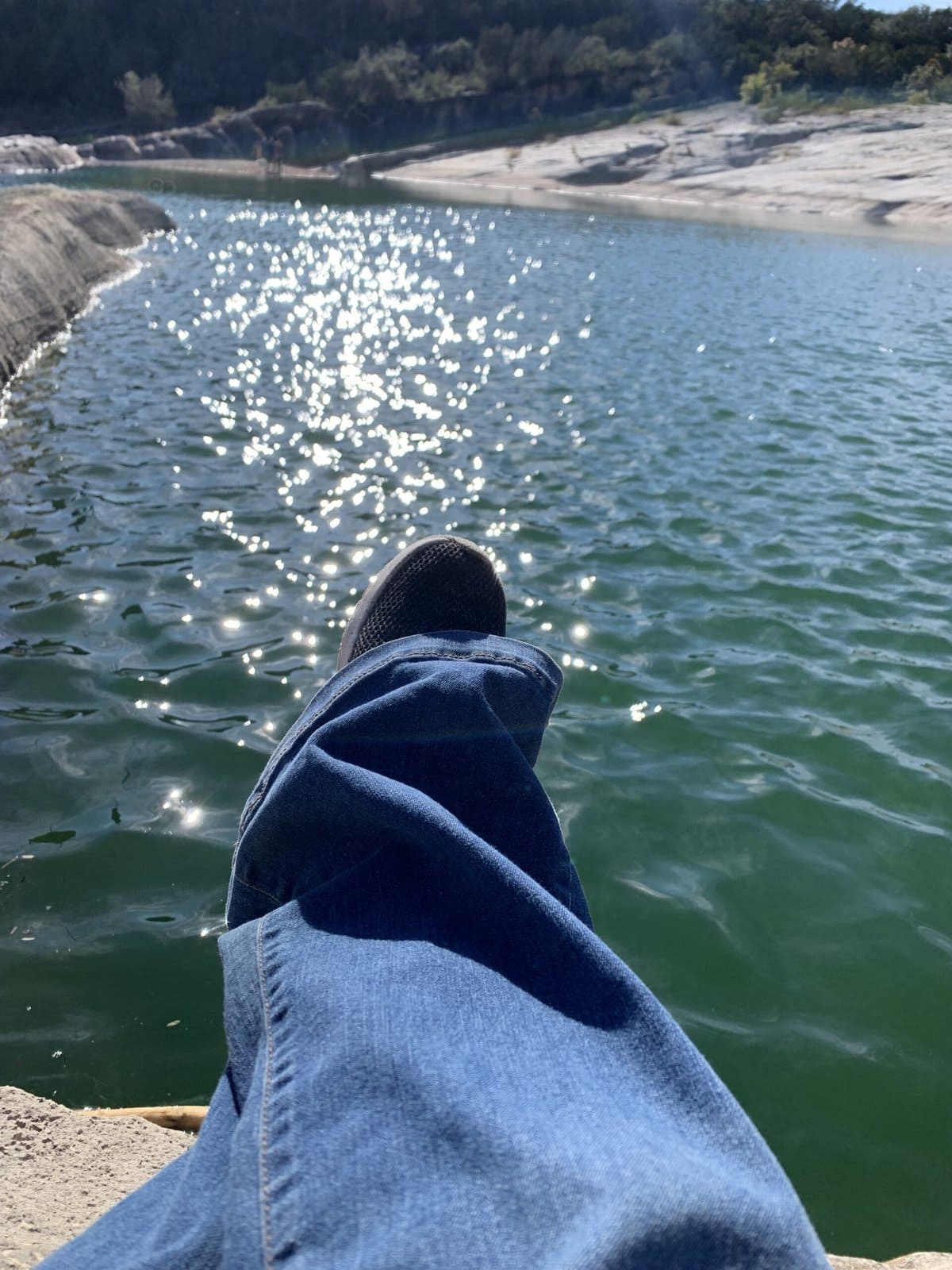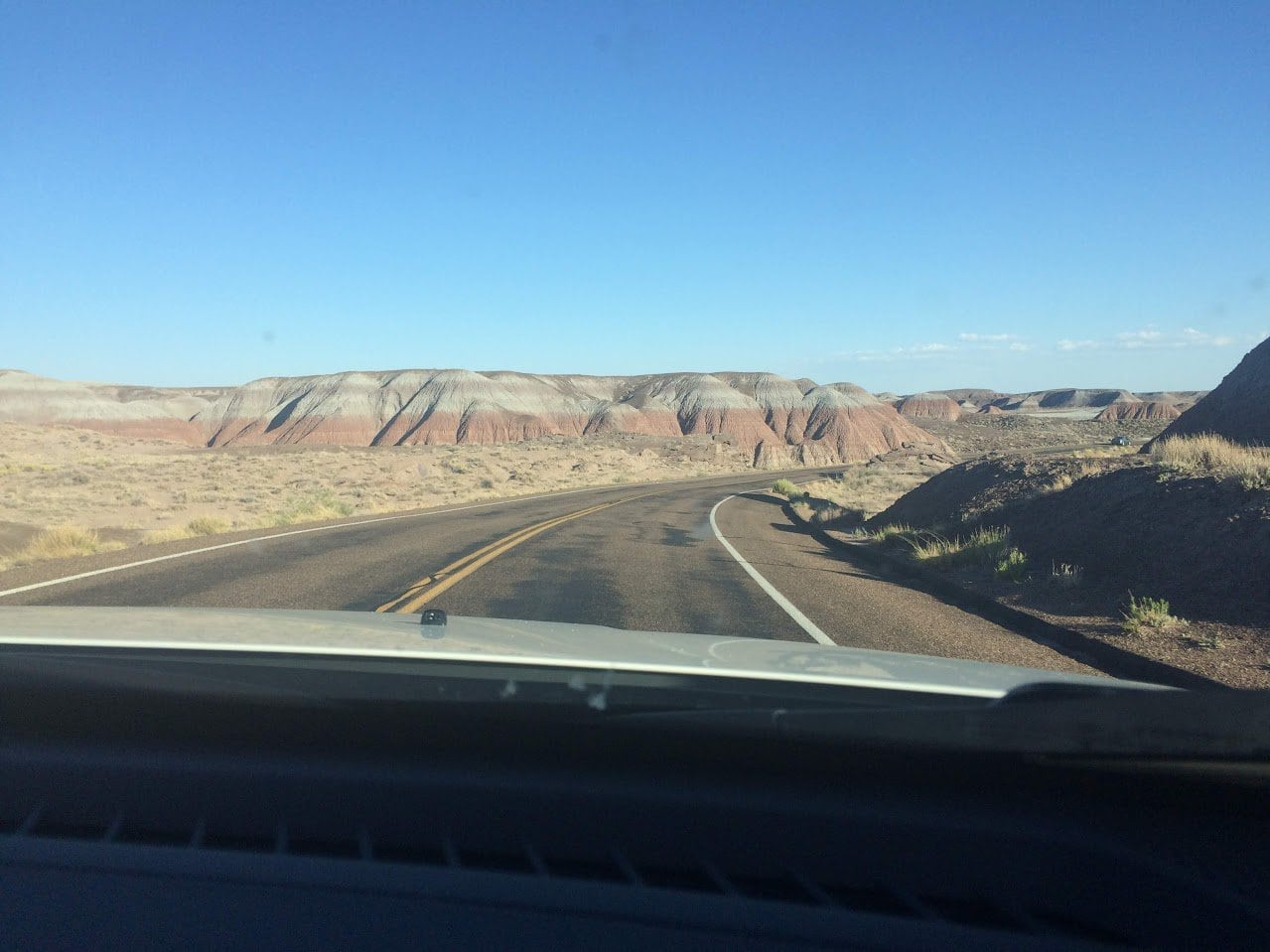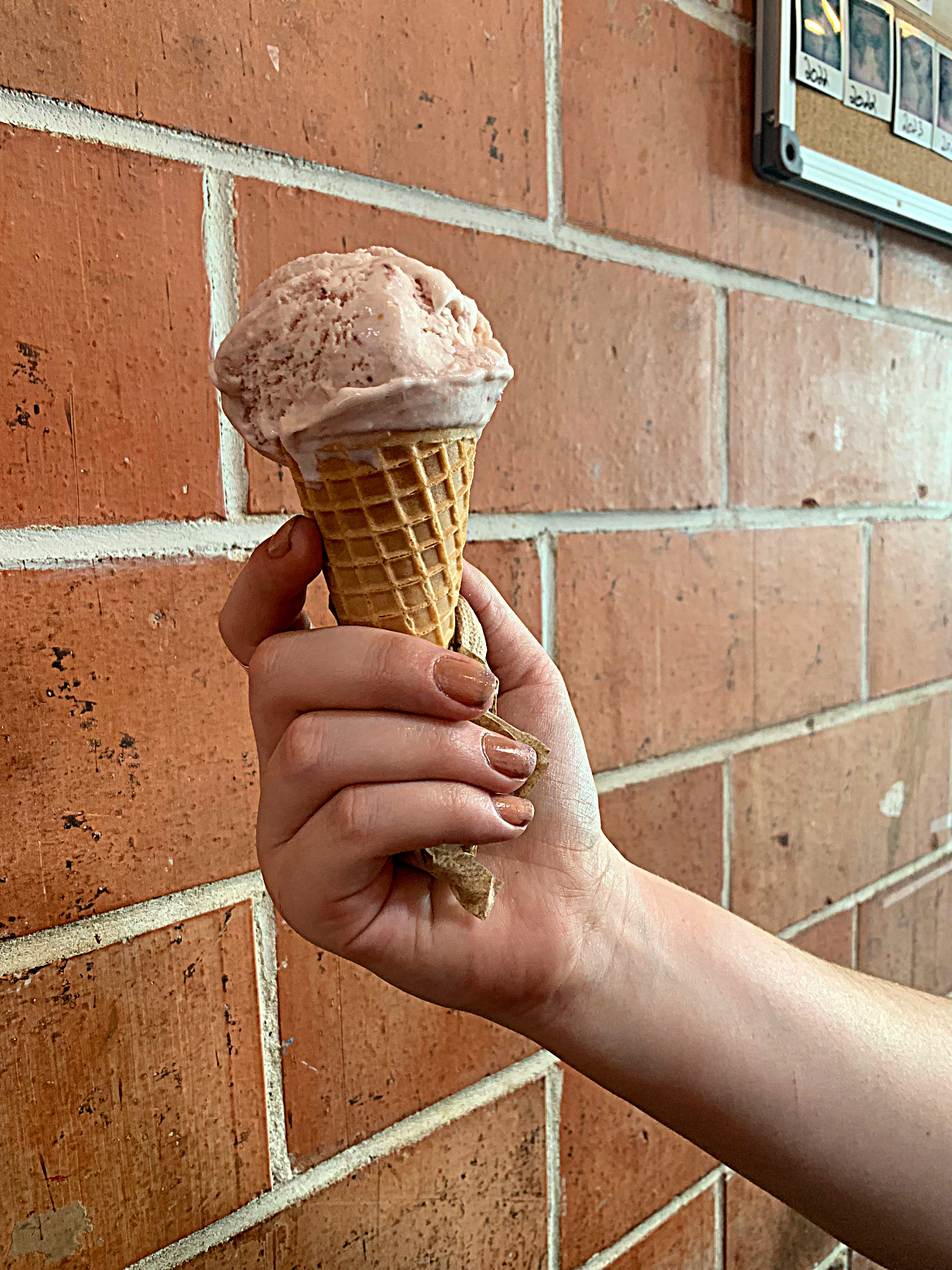Glacier National Park: 11 Exciting Things to See and Do
One of our favorite stops on the unforgettable 6,000-mile road trip was our two-day stop at Glacier National Park. What made this stop even more special was getting to spend it with family, sharing breathtaking views, wildlife encounters, and moments by the lake. Glacier’s rugged beauty and breath-taking landscapes made for the perfect break in our whirlwind adventure, and it quickly became a cherished memory for all of us.
In this post, we’ll cover everything you need to know about visiting Glacier National Park—from scenic drives like the iconic Going-to-the-Sun Road to camping under the stars by Lake McDonald. If you’re an outdoor lover or just seeking an unforgettable natural escape, Glacier offers something for everyone. By the time you finish this post, you’ll understand why this park should definitely be on your travel list.
Things to Know About Glacier National Park
During Summer 2020, the world was closed down and my family turned a NV1500 work vehicle into a camper van and decided to hit the road for a month long road trip. Glacier National Park was the place I think my husband was looking forward to the most.
We spent two days at the park, hiking, kayaking, drinking coffee, and some of the crazies even got in the water!
Best Time to Go
Spring (April to early June)
Spring brings the birth of wildlife, like moose calves, and the opportunity to see the aurora borealis at night if you’re lucky. However, many roads remain closed, so you’ll need to be self-sufficient and ready for unpredictable weather.
Shoulder Seasons (May to June, September to early October)
Visiting during the shoulder seasons offers fewer crowds and a quieter experience, though you’ll still get great access to many of the park’s best features. In the fall, the park’s colors are spectacular, and you might even spot more wildlife preparing for winter.
Summer (Late June to August)
The summer months are the most popular time to visit Glacier National Park. With warmer weather, all roads open, and most services in full operation, it’s ideal for activities like driving the iconic Going-to-the-Sun Road, hiking, rafting, and fishing. However, be prepared for crowds, especially at key spots.
Early July
If you visit in early July, you might catch a special sight—mountain goats trekking up the mountains while some snow still lingers. It’s a magical time when the park is transitioning from spring to summer.
Winter (Late November to March)
While the entrance fees are lower in winter, heavy snow covers much of the park, and many roads, including Going-to-the-Sun Road, are closed. Winter activities like cross-country skiing and snowshoeing are possible, but it’s best for those seeking solitude and prepared for cold conditions.
How to get there
By Air: Glacier Park International Airport (Kalispell)
The closest airport to Glacier National Park is Glacier Park International Airport (FCA), located about 30 miles from the park’s west entrance. After landing in Kalispell, renting a car is the easiest way to reach the park.
From the airport, head south on US-2 W toward West Glacier. This scenic drive takes about 40 minutes and brings you directly to the park’s west entrance. You’ll pass through Columbia Falls, a great spot to grab any last-minute supplies or a meal before entering the park.
Driving In:
From the South (Missoula, MT)
Take US-93 N to Kalispell, then merge onto US-2 E toward West Glacier. This route provides beautiful views of Flathead Lake before transitioning into stunning mountain scenery as you approach Glacier. The drive from Missoula to West Glacier is about 2.5 hours.
From the West (Spokane, WA)
If you’re driving from Spokane, follow I-90 E to US-93 N toward Kalispell. Then, continue east on US-2 E to reach the park’s west entrance. The total drive is roughly 5 hours, and you’ll pass through some lovely areas like Coeur d’Alene and Sandpoint, Idaho, along the way.
From the East (Great Falls, MT)
Coming from Great Falls, take US-89 N for the more scenic route to the park’s eastern side. The entrance near St. Mary is your best bet if you want to start on this side of the park, where you can access the Going-to-the-Sun Road. It’s about a 3-hour drive, with opportunities to spot wildlife and experience the more remote side of Glacier.
Alternate Eastern Route: Alternatively, you can continue north from Great Falls on I-15 N and cut over on US-2 W to reach the park’s quieter east entrances, such as Two Medicine or Cut Bank.
Packing for Camping at/near Glacier National Park
- Rain Jacket: A lightweight rain jacket with a hood is recommended. A poncho that can cover your day pack can also be helpful for surprise downpours.
- Hiking Boots: Waterproof boots with a sturdy sole and ankle support are essential for hiking in Glacier, especially since trails cross over 500 streams. Comfortable, broken-in boots will make a huge difference.
- Binoculars: Perfect for wildlife watching! Bighorn sheep, moose, and bears are common sights, and binoculars let you keep a safe distance.
- Camera: The scenic views in Glacier National Park are unbeatable, so having a camera (or your phone with a good camera) is a must for capturing those memories.
- Fleece Jacket: Even in summer, Glacier can get chilly, especially in the mornings or at higher elevations. A fleece jacket is perfect for layering and staying cozy.
- Waterproof Bag: Keep your electronics and important gear dry by packing them in a waterproof bag, especially if you’re hiking or near water.
- Waterproof Phone Case: Whether you’re caught in the rain or near water, this is a simple way to protect your phone from the elements.
- Extra Charging Cord: Bring an extra charging cord in case you lose one or need a backup at the campsite.
- Spare Batteries & Extra SD Card: For your camera, flashlights, or any other gadgets, spare batteries are essential. An extra SD card ensures you don’t run out of space for photos.
- Sandals: Water-friendly sandals are great for rafting, paddling, and fishing. They’re also nice to slip into after a long day of hiking.
- Trekking Poles: Perfect for long hikes, especially on uneven or steep terrain.
- Towel: For those brave enough to swim in Glacier’s chilly waters, having a towel is a must to dry off!
Additional Essentials to Consider:
- Bear Spray: Glacier National Park is home to both black and grizzly bears. Bear spray is a must for hiking, and it’s good to be familiar with how to use it.
- Reusable Water Bottle/Water Filter: Stay hydrated! There are water refill stations, but if you’re hiking deeper into the park, a filter can help with refilling from streams. I will always recommend a Hydroflask.
- Bug Spray & Sunscreen: Protect yourself from the bugs and sun! Even at higher elevations, the sun can be intense.
- First Aid Kit: Always pack a small first aid kit with band-aids, blister pads, antiseptic wipes, and any personal medications.
- Food & Snacks: Bring plenty of non-perishable food, especially if you’re camping. High-energy snacks like trail mix, jerky, and granola are great for long hikes.
- Headlamp/Flashlight: Essential for navigating your campsite at night or for early morning hikes. Don’t forget extra batteries!
- Camping Stove & Cookware: If you’re cooking at your campsite, a compact stove, fuel, and lightweight cookware are key. I have a great Shakshuka breakfast recipe for those chilly mornings!
- Map & Compass/GPS: Even with phone apps, having a map or GPS is handy in case you lose service. It’s good to stay prepared, especially in remote areas.
Where to Stay near Glacier National Park
Rocky Mountain Hi Campground- Kalispell
The Campground: Rocky Mountain Hi Campground
When it comes to camping, I highly recommend staying at Rocky Mountain Hi Campground in Kalispell. It’s conveniently located just outside of town, offering easy access to both Kalispell and Glacier National Park. We stayed in two tent spots (locations 89 and 90), which were perfect for our group. The girls loved being close enough to walk to the swimming hole and play area, which was a great way to relax after a long day of hiking in the park.
The campground itself is well-maintained, with excellent facilities. The showers had great water pressure (a huge plus after a day outdoors), and the laundry facilities were spacious and clean—this was important to us as it was one of two or three times we were able to do laundry on the trip. Whether you’re traveling by RV, tent, or just looking for a quiet spot near Glacier, Rocky Mountain Hi is a solid choice.
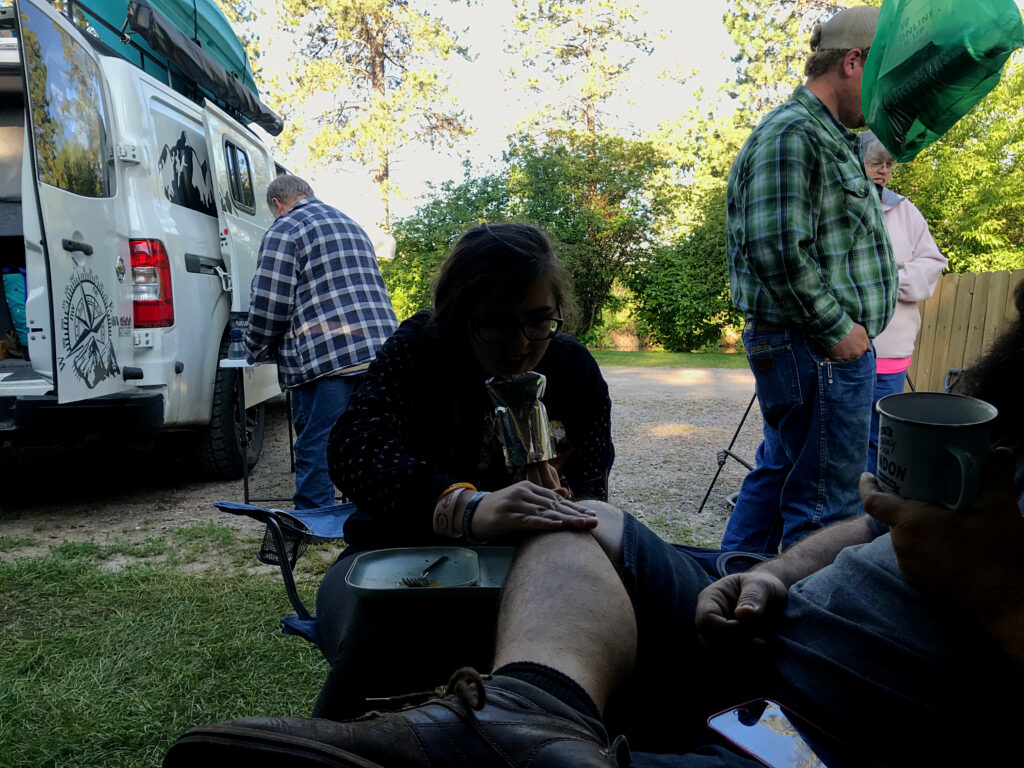

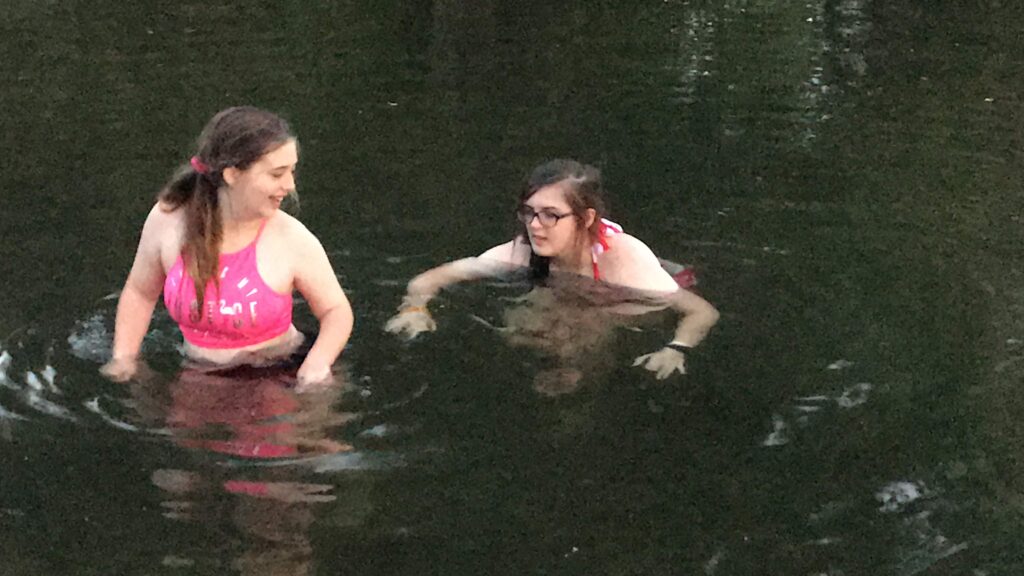
The town of Kalispell
Kalispell serves as a fantastic base for your Glacier National Park adventure. It’s a short drive (about 30 miles) to the park’s west entrance, and staying in town gives you access to amenities, dining, and last-minute gear shopping.
The town has 28,000 full-time residents, might seem small by most standards, but it’s considered a big town in Montana. Though we didn’t explore much of the town itself (since our primary focus was Glacier National Park), we did make a few memorable stops that are worth mentioning.
Dining in Kalispell: Famous Dave’s BBQ
One place we couldn’t pass up was Famous Dave’s BBQ, a spot that holds special memories for our family. We used to visit the BBQ joint when we lived in Delaware, and Brandon was especially excited to go back.
We indulged in fried pickles, smoky burnt ends, and a rum punch that was absolutely delicious. The drink is made with Cruzan Spiced Rum, hand-shaken with passion fruit puree, fresh pineapple, orange juice, and topped with grenadine—definitely a refreshing choice!


Shopping in Kalispell
Kalispell also offers a variety of stores, perfect for grabbing any last-minute outdoor gear. During our trip, I found some great hiking boots at a local shop (at a fantastic price, no less!). We also dipped into REI, which is a go-to spot for outdoor enthusiasts. Whether you need camping supplies, gear, or clothing, you’ll find quality items here. Even if you don’t need anything, it’s a fun place to browse and maybe pick up something for your next adventure.
Huckleberry Heaven
Montana is known for its huckleberries, and Huckleberry Heaven in Kalispell is the perfect place to stock up on these local treats. While I held off on buying anything (saving room for coffee!), the girls and Pa couldn’t resist. They picked up some huckleberry fudge and Twizzlers, which were big hits. If you’re a fan of huckleberries, you’ll find everything from jams to candies here.
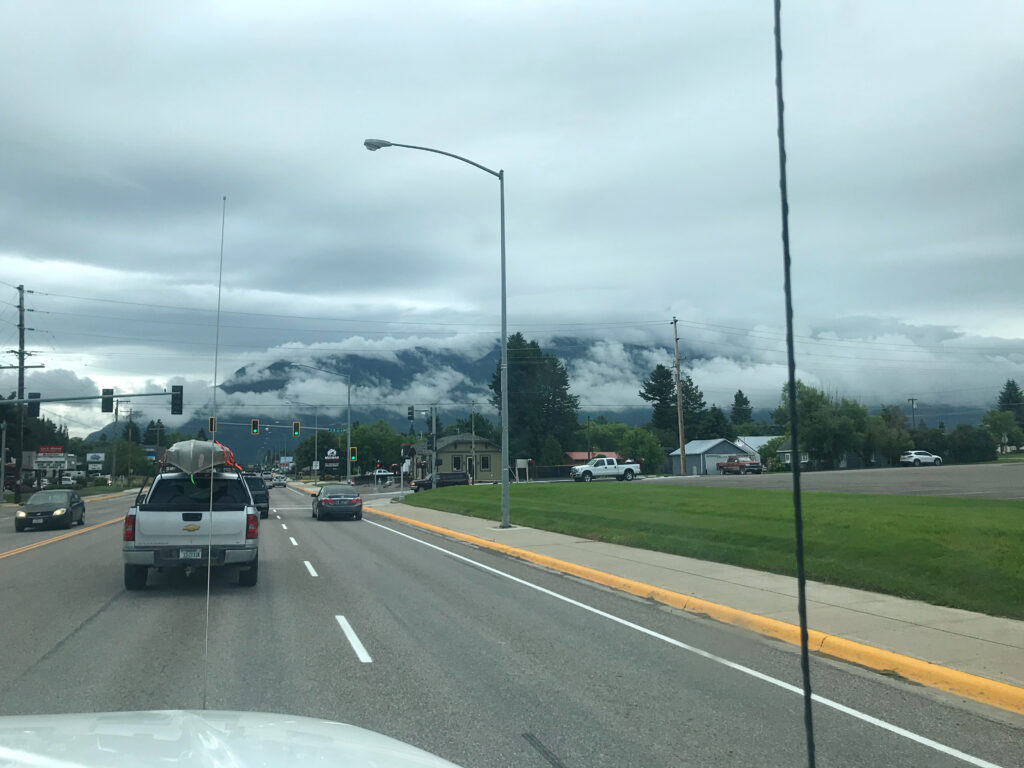
Staying Inside Glacier National Park
If you’re able to stay within the park, I highly recommend camping near the water—because, yes, nothing beats waking up to those views! There are several campgrounds within Glacier that offer fantastic proximity to the park’s attractions, and if you love the idea of sleeping under the stars with nature all around you, these are great options:
Sprague Creek Campground
- Location: Near Lake McDonald and Going-to-the-Sun Road
- Size: 25 campsites
- Highlights: Sprague Creek is a smaller, more intimate campground located right along Lake McDonald. The lakeside sites offer stunning views, but because of its location, it can get busy, especially during the peak summer months. It’s an ideal spot for those looking to be close to both the water and the iconic Going-to-the-Sun Road.
- Things to Note: While the proximity to Lake McDonald is amazing, keep in mind that cell reception is very limited here. If you’re looking to unplug and get away from it all, this could be the perfect spot for you. However, it fills up quickly, so plan ahead!
Apgar Campground
- Location: Near Lake McDonald, west side of the park
- Size: 194 campsites
- Highlights: Apgar Campground is Glacier’s largest campground and offers more spacious sites than Sprague Creek. It’s also open for longer stretches of the year, making it a great option if you’re visiting during the shoulder seasons. It’s close to both Lake McDonald and Apgar Village, where you’ll find amenities like gift shops and a visitor center.
- Things to Note: This campground can accommodate larger RVs, so it’s a good pick for those traveling with bigger setups. Cell service here is a little better than at Sprague Creek, though still spotty.
Rising Sun Campground
- Location: East side of the park, near St. Mary’s Lake
- Size: 83 campsites
- Highlights: Located on the eastern side of the park, Rising Sun Campground is perfect for those who want to explore the east side and Logan Pass. It offers views of St. Mary’s Lake, making it a beautiful place to camp, especially at sunrise. It’s also conveniently located near several hiking trails, so it’s a great spot for outdoor enthusiasts.
- Things to Note: Bears are frequently reported in this area, so make sure to follow all bear safety protocols, including storing your food in bear-proof containers. The campground is also a bit quieter than the busier west side of the park.
Pro Tip:Campsites inside Glacier National Park are available on a first-come, first-served basis, so arriving early is essential, especially during peak season.
Some campgrounds, such as Fish Creek and St. Mary, offer reservation options through Recreation.gov, which can take a lot of stress out of planning your trip.
Things To Do in Glacier National Park
Just Before You Enter: West Glacier Village
Before heading into the park on our second day, we made a quick stop at West Glacier Village, located just outside the park’s West Entrance. This little village is the perfect basecamp for your Glacier adventures, offering restaurants, shops, and even lodging options. Plus, it’s just a short mile up the road from the Apgar Visitor Center, where you can chat with Park Rangers and get some hiking recommendations if you’re not sure where to start.
While everyone else relaxed, Nevaeh and I wandered into the West Glacier Village Café in search of coffee. If you’ve never had huckleberries, they taste similar to blueberries but with a more intense, slightly tart flavor. So naturally, when I saw huckleberry coffee on the menu, I had to give it a try.
If you are not a berry-with-coffee kind of person, this is not the coffee you’re looking for.
Yes, that’s my inner Star Wars fan coming through. But seriously, huckleberry-flavored treats aren’t something you find just anywhere in the U.S., so if you’re up for a unique Montana experience, this is your chance. Although it was early July, the mornings were still brisk enough that a hot huckleberry latte really hit the spot as we sipped and soaked in the views of the nearby lake.
Pro Tip: If huckleberry-flavored coffee sounds too adventurous, don’t worry—the café has plenty of other options to fuel you up for a day of exploring the park.
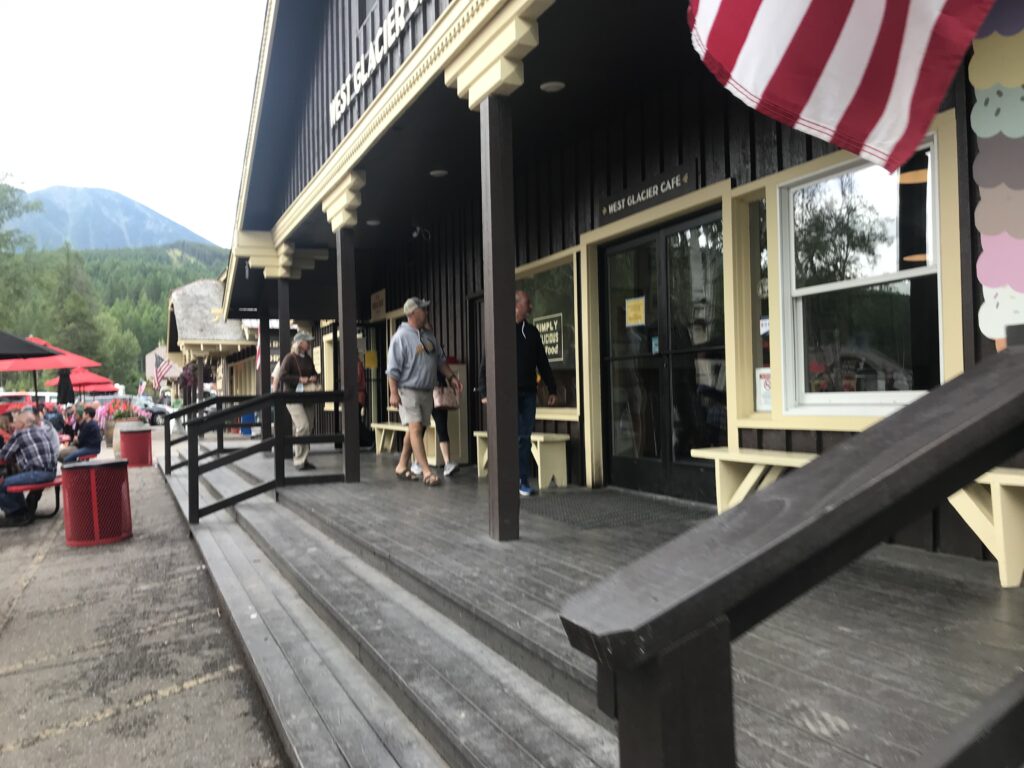
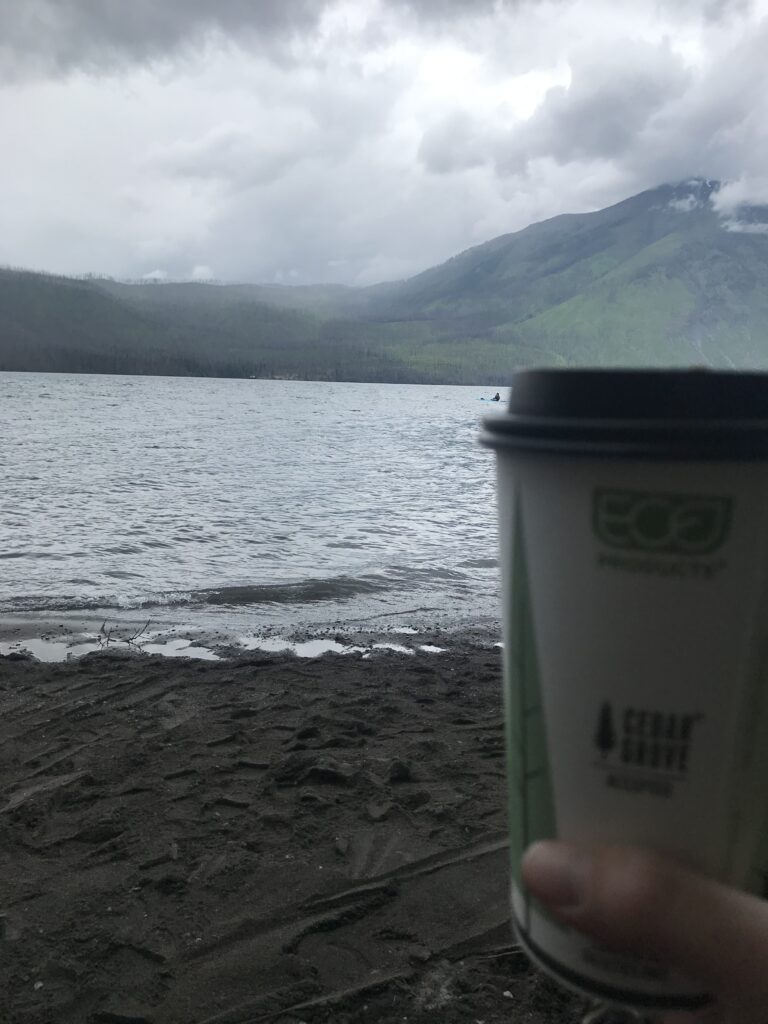
Entering Glacier National Park & Visiting Apgar Visitor Center
One of the first things you’ll want to do when entering Glacier National Park after snapping pictures at the entrance is to stop by the Apgar Visitor Center.
Located just inside the West Entrance, it’s the perfect starting point for gathering information and planning your day. The visitor center sits at the four-way stop intersection of Camas Road and Going-to-the-Sun Road, roughly two miles north of the West Glacier entrance. Naturally, it is convenient for travelers coming in from Kalispell or other nearby towns.
Hours & Amenities: The Apgar Visitor Center is open daily from mid-May to mid-October, with limited weekend hours in the off-season.
It offers a variety of amenities, including:
- Trip Planning Information & Exhibits: Helpful displays both inside and outside to learn about the park’s history, ecology, and wildlife.
- Restrooms: These are open year-round, which is a blessing for early risers or late-season visitors.
- Water Filling Stations: Perfect for refilling your reusable water bottles before heading into the park.
- Bookstore & Giftshop: Operated by the Glacier National Park Conservancy, the bookstore has a great selection of maps, guides, souvenirs, and educational materials.
- Free WiFi: This can be handy for downloading maps or checking trail conditions.
- Ranger-led Activities & Programs: During the summer months, rangers lead various programs, including astronomy nights, guided hikes, and wildlife talks. Check the schedule when you arrive to see what’s available.
- Shuttle Service: If you’re planning to hike or explore different parts of the park, the shuttle service can be a great way to get around, especially during peak season when parking can be limited.
- Parking: The parking lot has plenty of space, but it does fill up quickly during the summer. It’s also the primary shuttle pickup point, so it’s ideal for leaving your car behind.
- Sustainability:The Apgar Visitor Center is also a pioneering model for sustainable construction, which fits perfectly with Glacier National Park’s mission to protect and preserve the environment.
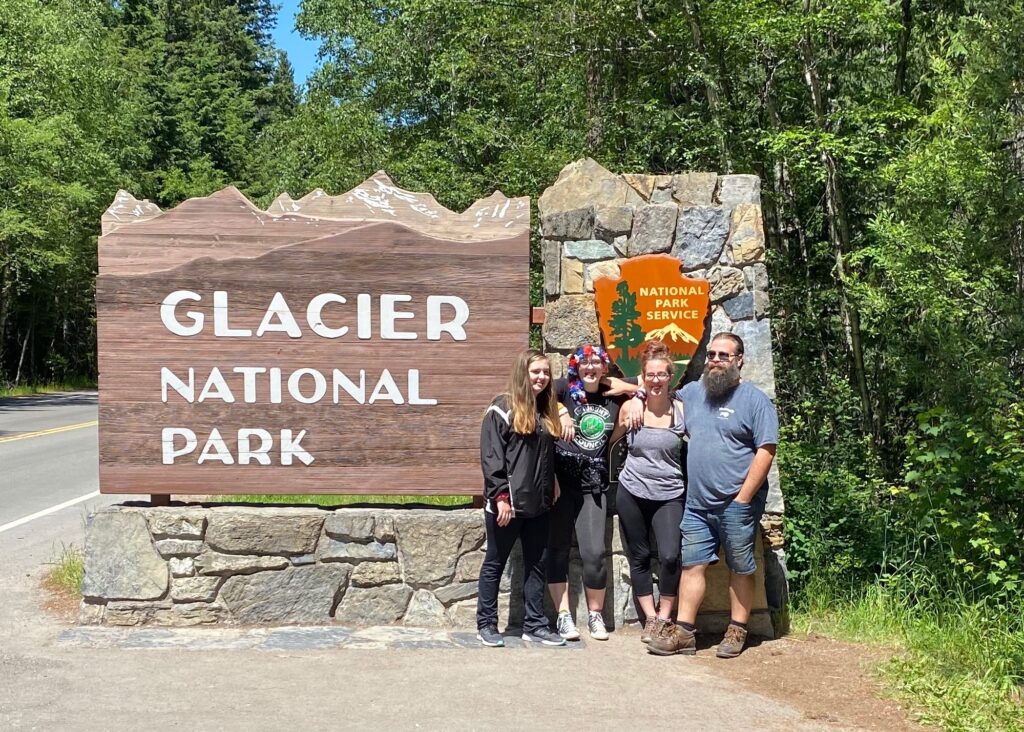
From Apgar to Lake McDonald Lodge
After exploring the visitor center and grabbing any last-minute souvenirs or trip details, we made our way toward Lake McDonald Lodge. Located along the beautiful Going-to-the-Sun Road, this historic lodge is one of the park’s most iconic destinations. Between the entrance and the lodge, we had a surprise wildlife sighting—a bear cub hanging out near the road! It created quite the traffic slowdown, as people carefully pulled over, unsure if they should be cautious or trying to snap photos. (Probably both!)
Bear Safety Tip:
While it’s exciting to see wildlife up close, it’s important to stay in your vehicle and maintain a safe distance—both for your safety and for the animals’. Glacier is home to both black bears and grizzlies, so having bear spray in your car or on you when hiking is a must.
Hiking to McDonald Falls in Glacier National Park
When no one could decide what they wanted to do next, I suggested we hike to McDonald Falls—a relatively easy hike along the highway. While the proximity to the road makes it a more accessible option, it’s important to stay aware of traffic and take extra care if you’re hiking with kids.
The falls themselves are visible from the road, but there’s a small offshoot trail that lets you walk closer for a better view. Though McDonald Falls wasn’t as large as I’d anticipated, it still didn’t disappoint. The water flowed swiftly and powerfully. Thankfully, we had most of the area to ourselves, catching a few people on our way in and their way out.
One of the highlights of hiking in Glacier National Park is the wildlife, and this trail was no exception. Along the way, we spotted a few deer, and we were able to get relatively close. The encounter was one of those special moments that Glacier is known for, where nature and adventure meet.
Vaeh, being the adventurous spirit she is, even filled her bottle with water directly from the falls and drank it without hesitation. Growing up, I’d always heard that drinking water from mountain streams was okay because it’s cleaner, especially further north and in more remote areas. While I wouldn’t necessarily recommend it for everyone, she is the brave soul and who am I to tell her no? Besides, I my brother-in-law’s water from this region was some of the best I’ve ever had!
On our way back from the falls, we took pictures of the ducks that were gliding along the water and enjoyed the quiet atmosphere. From there, we made our way back to Lake McDonald, exploring its sparkling waters. We took out the kayaks, some choosing to stay closer to the shoreline, while others ventured further out. And of course, the real adventurers (Vaeh and her dad) even braved the cold water for a swim!

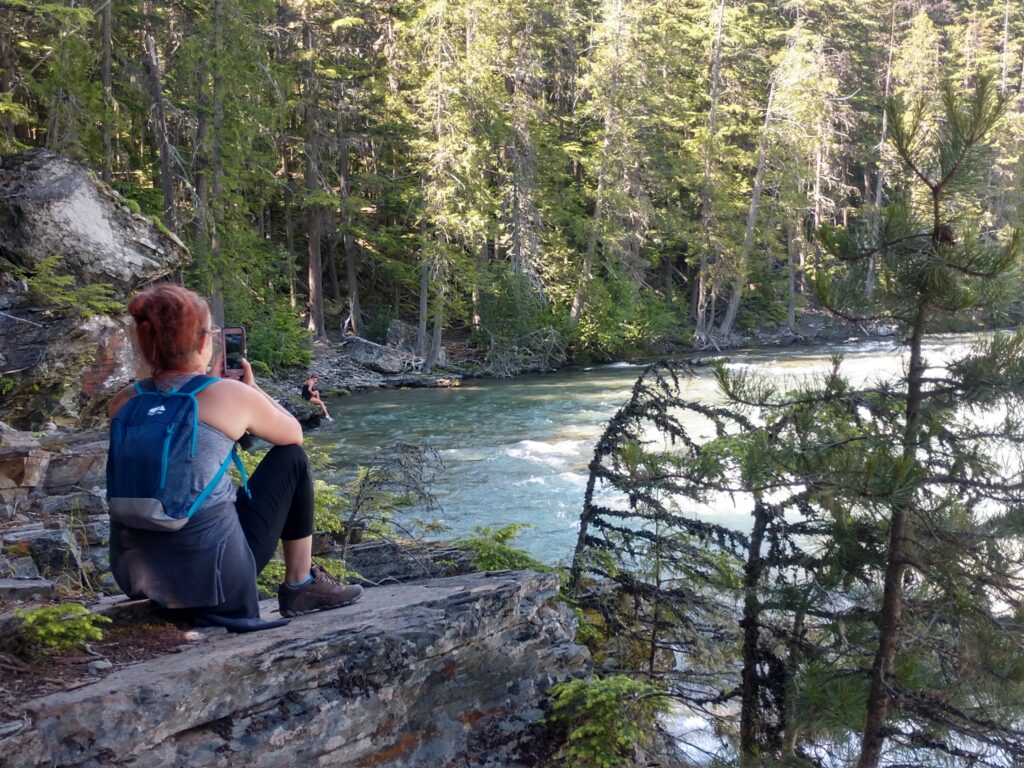
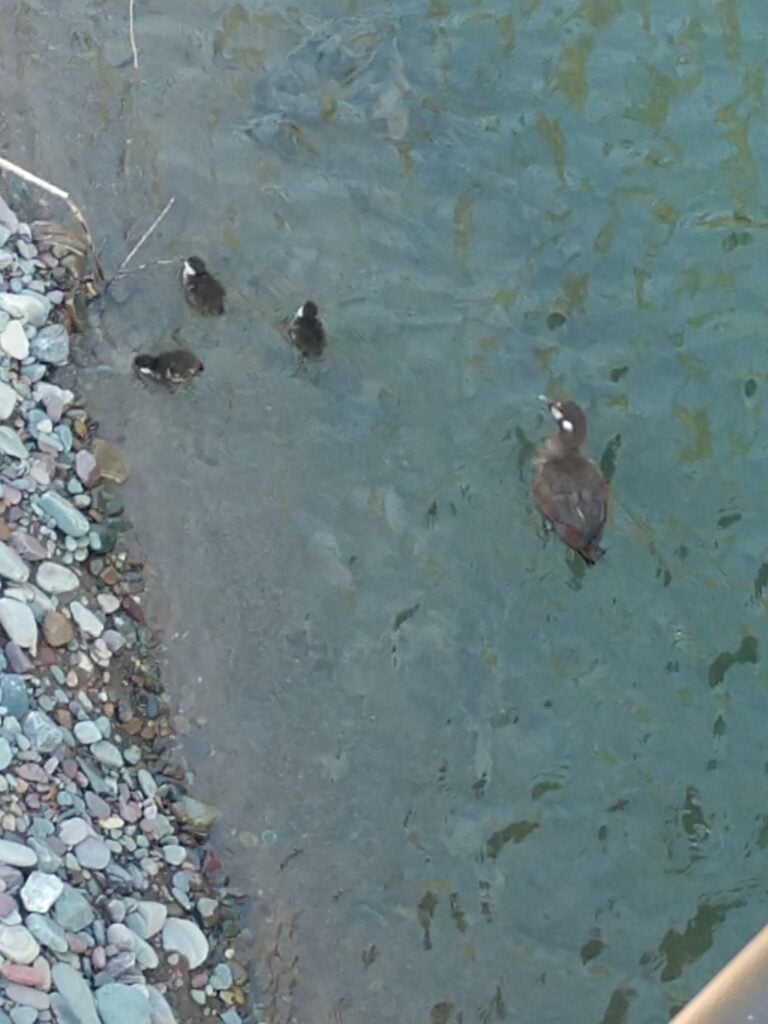
Going-to-the-Sun Road
One of the most iconic experiences in Glacier National Park is driving the Going-to-the-Sun Road. Stretching 50 miles across the park, this scenic route offers jaw-dropping views of alpine meadows, glaciers, waterfalls, and wildlife, making it one of the most breathtaking drives in North America.
Seasonality & Accessibility:
While the lower elevation portions of Going-to-the-Sun Road are open year-round, the alpine sections (including Logan Pass) usually open by early July, depending on snow and plowing conditions. The road typically stays open until mid-October, but always check current conditions before heading out, as portions can close unexpectedly due to weather. You can find the latest updates on the NPS Plowing and Road Status page.
Pro Tip: If you’re visiting during the peak season (late June to mid-September), plan ahead. From May 24 to September 8, vehicle reservations are required between 6 a.m. and 3 p.m. to enter Going-to-the-Sun Road from the west.
Half of these passes are available four months in advance and can sell out quickly, so make sure to book ahead. If you don’t snag a reservation, passes are also released daily at 7 p.m. for the next day.
Driving the Road
Logan Pass:
At 6,646 feet, Logan Pass is the highest point on the Going-to-the-Sun Road. It’s 32 miles from the west entrance and 18 miles from the east entrance at St. Mary.
The parking lot at Logan Pass fills up fast, often by sunrise, so getting an early start is essential if you want to park here. The views from Logan Pass are worth it, with incredible vistas, wildlife, and access to the famous Hidden Lake Overlook trail.
Scenic Sights:
As you drive along Going-to-the-Sun Road, you’ll find it nearly impossible not to stop at the many pull-offs to soak in the scenery. Here are a few must-see spots along the way:
- Heaven’s Peak: A towering mountain visible from the road, perfect for photos.
- Bird Woman Falls: A stunning waterfall cascading down from the cliffs above.
- Weeping Wall: A high priority on my bucket list, this unique feature is 100 feet long and gushes torrents of water during the early summer snowmelt. It’s a popular stop for photographers, and if you’re hiking in the area, it’s not uncommon to see people cooling off in the water. Just be prepared to get wet—roll up your windows if you’re driving through, or you’ll get soaked!
- Jackson Glacier Overlook: The best spot along the road to catch a glimpse of one of the park’s glaciers.
- Wild Goose Island Overlook: A picturesque view of St. Mary Lake, especially stunning at sunrise.
Planning Your Drive
- Start Early: Traffic builds up fast, especially at Logan Pass. Heading out early also increases your chances of spotting wildlife, like mountain goats, bighorn sheep, or even grizzly bears.
- Pack Smart: There are no gas stations inside the park, so fuel up at West Glacier Village or St. Mary before heading in.
Bring plenty of snacks and water, as services are limited along the route.
Picnicking at Logan Pass or at one of the scenic turnouts is a perfect way to break up your drive.
Weather-Ready: Glacier’s weather can change quickly, especially at higher elevations. Dress in layers, pack a rain jacket, and be prepared for cooler temperatures at Logan Pass. - Experience the Wild Side of Glacier: Wildlife sightings are a big part of the magic of Going-to-the-Sun Road. Mountain goats and bighorn sheep are often spotted near Logan Pass, while grizzly bears have been seen closer to Two Dog Flats on the east side.
Always remember to stay in your vehicle and view wildlife from a safe distance to ensure both your safety and theirs.
Prefer to leave the driving to someone else? Shuttle services are available, allowing you to sit back and enjoy the views. Guided tours and transportation options are also available from both the west and east sides of the park.
2 Day Itinerary For Glacier National Park
From the serene beauty of Lake McDonald to the awe-inspiring drive along Going-to-the-Sun Road, Glacier National Park offers a blend of adventure, tranquility, and unforgettable experiences.
If you haven’t already added it to your travel list, we highly recommend making Glacier a priority. It’s a place where you can unplug, explore, and create memories that will stay with you long after you leave.

